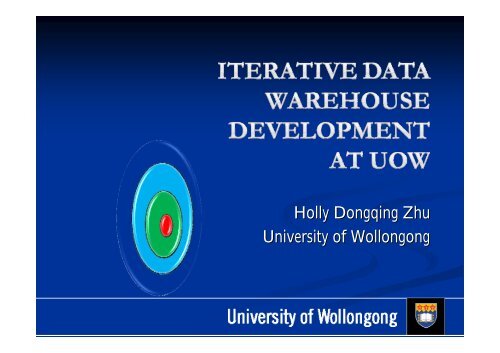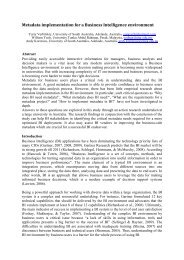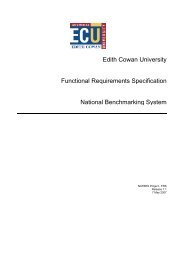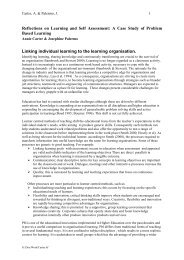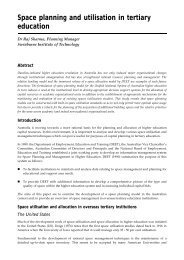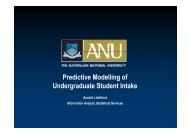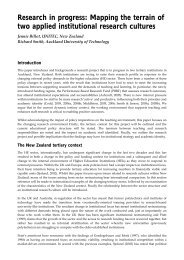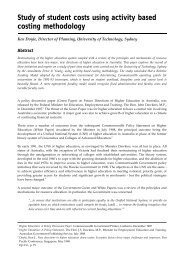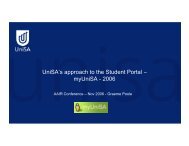Holly Dongqing Zhu University of Wollongong - aair
Holly Dongqing Zhu University of Wollongong - aair
Holly Dongqing Zhu University of Wollongong - aair
Create successful ePaper yourself
Turn your PDF publications into a flip-book with our unique Google optimized e-Paper software.
<strong>Holly</strong> <strong>Dongqing</strong> <strong>Zhu</strong><br />
<strong>University</strong> <strong>of</strong> <strong>Wollongong</strong>
The Method <strong>of</strong><br />
Fishing
We Aim to …
• Background<br />
• Development Methodology<br />
• Conclusion
The <strong>University</strong> <strong>of</strong> <strong>Wollongong</strong><br />
• No. 1 Teaching <strong>University</strong> in Australia<br />
• 23,000+ Students<br />
• 2,000+ Full Time Staff<br />
• 81,000+ Alumni<br />
• 8 Campuses
The BI Competency Centre<br />
• Competency Centre Established<br />
• Data covering 7 Key <strong>University</strong> Perspectives<br />
• Over 300 Users<br />
• Currently on Cognos 8.3
BI Architecture<br />
Balanced Scorecards<br />
& Digital Dashboards<br />
Detailed<br />
Analysis<br />
Transactional<br />
Reports<br />
Data<br />
Warehouse<br />
Research<br />
JD<br />
Edwards<br />
Monitor<br />
Analyse<br />
Report<br />
Gather<br />
Students HR External Other<br />
Source Systems<br />
P<br />
E<br />
R<br />
F<br />
O<br />
R<br />
M<br />
A<br />
N<br />
C<br />
E<br />
I<br />
N<br />
D<br />
I<br />
C<br />
A<br />
T<br />
O<br />
R<br />
S<br />
S<br />
E<br />
C<br />
U<br />
R<br />
I<br />
T<br />
Y<br />
W<br />
E<br />
B<br />
P<br />
O<br />
R<br />
T<br />
A<br />
L
7 Key Perspectives At UOW
• Give All Decision-makers<br />
Information
HOW
Traditional Methodology<br />
– Waterfall
Traditional Methodology<br />
– Waterfall<br />
“....we build systems like the way the Wright<br />
brothers built airplanes -- build the whole thing,<br />
push it <strong>of</strong>f a cliff, let it crash, and start over<br />
again.”<br />
R.M. Graham (1969)
Traditional Methodology<br />
- Bottom-up<br />
• Design DW without a Complete Business<br />
Design<br />
• Strength<br />
• Quick Result<br />
• Not Require to Have Lots <strong>of</strong> Knowledge at Top<br />
Level<br />
• Weakness<br />
• Lack <strong>of</strong> a Global Purpose<br />
• May Suffer from a Tangle <strong>of</strong> Tables
What is the Data Warehouse<br />
Development Methodology we<br />
adopt at UOW
Iterative Methodology Overview
Iterative Methodology Process
Iterative Methodology -<br />
Initiate Phase<br />
• Setup Initial Business Vision<br />
• Gain Initial Stakeholder Support<br />
• Identify Initial Scope<br />
• Have Initial High-level Plan
Iterative Methodology -<br />
Analysis Phase<br />
• Understand Business Needs<br />
• Understand the Technical Capability<br />
• Data Pr<strong>of</strong>iling
Iterative Methodology -<br />
Analysis Phase<br />
• Data Pr<strong>of</strong>iling Strategy<br />
• Column Pr<strong>of</strong>iling<br />
• Dependency Pr<strong>of</strong>iling<br />
• Cross-table Pr<strong>of</strong>iling
Iterative Methodology –<br />
Prototyping Phase<br />
Capture an initial set <strong>of</strong> needs and implement<br />
quickly those needs with a stated intend <strong>of</strong><br />
iteratively expanding and refining them as mutual<br />
user/developer understanding <strong>of</strong> the system<br />
grows.<br />
Definition <strong>of</strong> the system grows through gradual<br />
and evolutionary discovery as opposed to<br />
omniscient foresight.<br />
S<strong>of</strong>tware Engineering Pr<strong>of</strong>. G. Lyons, NUI Galway
Iterative Methodology –<br />
Prototyping Phase<br />
• Quick Design and Build Prototype<br />
• Get Evaluation and Feedback<br />
• Refine Prototype
Iterative Methodology –<br />
Testing Phase<br />
• Regression Test<br />
• SIT Test<br />
• UAT Test
Iterative Methodology –<br />
Deploy Phase<br />
• Migration<br />
• Communication<br />
• Training
It has only just begun …
Interactions
Advantages!<br />
• Manage Changes Effectively<br />
• Improved Data Quality and Usability<br />
• Manage Risks Early on<br />
• Robust Architecture<br />
• And more…<br />
Quick Result<br />
Integrate Elements Progressively<br />
Well-managed Relationship with Stakeholders<br />
More Capable Team<br />
……
Take An Example<br />
….
Institutional Attrition Project
Prototype 1 - Attrition Fact Table<br />
FACULTY_D<br />
DATE_D<br />
AGE_D<br />
STUDENT_D<br />
CITIZENSHIP_D<br />
COURSE_D<br />
COURSE_ATTRITION_STATUS<br />
COURSE_COMMENCING_YEAR_D<br />
CAMPUS_D
Prototype 2 - Attrition Fact Table
Prototype 3 - Attrition Fact Table<br />
LAST_ENROLMENT_SESSION_D<br />
FACULTY_D<br />
DATE_D<br />
UAI_D<br />
WAM_D<br />
AGE_D<br />
STUDENT_D<br />
CITIZENSHIP_D<br />
COURSE_D<br />
ATTRITION_STATUS_D<br />
COURSE_COMMENCING_YEAR_D<br />
CAMPUS_D
Final Design -Attrition Fact Table<br />
LAST_ENROLMENT_SESSION_D<br />
DATES_D<br />
WAM_D<br />
ENROLMENT_LAST_SESSION_D<br />
STUDENT_D<br />
FACULTY_D<br />
MAJOR_D<br />
ENROLMENT_ANNUAL_D<br />
COURSE_D<br />
COURSE_ATTRITION_STATUS<br />
COURSE_COMMENCING_YEAR_D<br />
AGE_D<br />
CAMPUS_D<br />
DOUBLE_DEGREE_D<br />
CITIZENSHIP_D
Final Design -Attrition Fact Table
Original Course Fact Table
Final Design - Course Fact Table<br />
DOUBLE_DEGREE_D<br />
STUDENT_D<br />
COURSE_STATUS_D<br />
FACULTY_D<br />
AGE_D<br />
CAMPUS_D<br />
MAJOR_D<br />
DATES_D<br />
COURSE_D<br />
CITIZENSHIP_D<br />
(ENROLMENT ANNUAL)<br />
ANNUAL_LIABILITY_D<br />
COURSE_COMMENCING_YEAR_D
Final Design - Course Fact Table
Attrition Project Process Review<br />
•New Requirements<br />
•Changed Requirements<br />
•Issues Identified<br />
•Data Quality Issues<br />
•Improved Logic<br />
•Refined Metadata<br />
•More Capable Team<br />
•Well Managed Relationship<br />
•…….
Dummy Data!!!
Dummy Data!!!
Conclusion<br />
• DW Development Methodology Matters.<br />
• Choose a Methodology Which Makes Data<br />
Warehouse Development as Agile as Possible!
QUESTIONS<br />
Que<br />
stio<br />
ns


